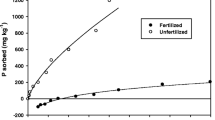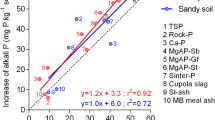Abstract
A large variety of soil samples was collected from farms located in two north-eastern regions of France. Their phosphate fertility was assessed by the isotopic exchange kinetics method which allows for the measurement of a r1/R ratio, where r1 is the quantity of radioactivity still present in solution one minute after the injection of a quantity of radioactivity R into a soil-solution system at steady-state. The r1/R parameter gives an estimate of the soil fixing capacity for phosphate ions (PFC). Results of the analysis of 233 soil samples revealed that the great majority of soils from these areas exhibit a high PFC. Neither the soil type nor mode of utilization appeared sufficient for prediction of the PFC. Attempts to express the PFC as a function of other soil parameters (pH, clay, organic matter, calcium carbonate and exchangeable cations), resulted in a significant regression equation involving soil clay content and soluble phosphate. Due to high PFC of soils in the Lorraine area, phosphate fertilizer could be applied at a time as close as possible to the plant requirements.
Similar content being viewed by others
References
Admont P, Boniface R, Fardeau JC, Jahiel M and Morel C (1986) Currently used methods of measuring available soil P: their use in assessing the fertilizer value of rock phosphates. Fertilizers and Agriculture 92: 39–50
Barrow NJ (1980) Differences among some north American soils in the rate of reaction with phosphate. J Environ Qual 9: 644–648
Barrow NJ (1980) Evaluation and utilization of residual phosphorus in soils. In Khasawneh FE, Sample EC and Kamprath EJ (eds) The role of phosphorus in agriculture, pp 333–359, Madison Wis., Am Soc Agron
Barrow NJ (1984) Modeling the effect of pH on phosphate sorption by soils. J Soil Sci 35: 283–297
Barrow NJ and Shaw TC (1975) The slow reactions between soil and anions: 3. The effects of time and temperature on the decrease in isotopically exchangeable phosphate. Soil Sci 119: 190–197
Boniface R and Trocmé S (1988) Essais sur la fertilisation phosphatée. In Phosphore et potassium dans les relations sol-plante. Conséquences sur la fertilisation. pp 279–402. INRA Paris Editeur
Castillon O (1988) Modalités d'apport des engrais phosphatés et potassique sur céréales. Perspectives Agricoles 127: 101–102
Chevignard T, Fardeau JC, Doubeau-Piasco S, Feller C, Turenne JF and Vallérie M (1986) Effets du remodelage parcellaire sur la fixation des phosphates en divers types de sols des Antilles. Agronomie 6: 149–156
Daubeny CGB (1845) On the distinction between dormant and active ingredients of the soil. J Roy Agri Soc Eng 7: 237–245
Diatta S and Fardeau JC (1978) Etude au moyen de32PO4 et42K de l'action des amendements organiques sur la régénération des sols rouges du Sénégal. Comptes Rendus Colloque International IAEA. SM235/37
Dyer B (1894) On the analytical determination of probably available ‘mineral’ plant-food in soil. J Chem Soc London 65: 115–166
Fardeau JC (1981) Cinétiques de dilution isotopique et phosphore assimilable des sols. Thèse d'Etat, University of Paris VI, 198p
Fardeau JC (1984) Results of direct measurements of the utilization coefficient in fertilizers by isotopic labelling with32P,15N and40K. Fertilizers and Agriculture 86: 23–30
Fardeau JC, Diatta S, N'Diaye JP and Jappe J (1982) Choix de la fertilisation phosphorique dans quelques sols du Sénégal: utilisation du phosphore 32. Agronomie Tropicale 38: 103–109
Fardeau JC, Guiraud G and Jappe J (1976) Use of32PO4 isotopic dilution kinetics: expectation of fertilizing effect of some phosphatic fertilizer. International Fertilizer Congress, Moscow 3: 362–370
Fardeau JC, Morel C and Jahiel M (1988) Does long contact with the soil improve the efficiency of rock phosphate? Results of isotopic studies. Fert Res 17: 3–19
Fardeau JC and Jappe J (1978) Analyse par dilution isotopique de la fertilité et de la fertilisation phosphorique de quelques sols du Quebec. Canadian J of Soil Sci 58: 251–258
Fardeau JC, Migadel F, Malja S and Gjermani A (1983) Efficacité d'un phosphate à faible teneur dans quelques sols d'Albanie mesurée au moyen de32P. In Third International Congress on Phosphorus Compounds Proceedings, pp 519–532 Imphos Ed, Casablanca
Fardeau JC, Morel C and Jappe J (1985) Cinétique d'échange des ions phosphate dans les systèmes sol-solution. Vérification expérimentale de l'équation théorique. C R Acad Sci, Paris 300: 71–376
Fox RL and Kamprath GL (1970) Phosphate sorption isotherms for evaluating the phosphate requirements of soils. Soil Sci Soc Am J 34: 902–907
Frossard E (1985) Etude expérimentale de l'influence de composés organiques sur l'évolution des ions phosphates en sol ferrallitiques. Thèse de Doctorat, Institut National Polytechnique de Lorraine, F-Nancy, 130 p
Gachon L (1969) Les Méthodes d'appréciation de la fertilité phosphorique des sols. Bulletin de l'AFES 4: 17–31
John MK (1970) Colorimetric determination of phosphorus in soil and plant materials with ascorbic acid. Soil Sci 109: 204–220
Joret G and Hébert J (1955) Contribution à la détermination du besoin des sols en acide phosphorique. Ann Agron 233–299
Memon KS and Fox RL (1983) Utility of phosphate sorption curves in estimating the phosphorus requirements of cereal crop wheat (Triticum aestivum). In IMPHOS-Casablanca, ed. 3rd International congress on phosphorus compounds, Brussels pp 217–230
Morel C and Fardeau JC (1987) Le phosphore assimilable des sols tropicaux: ses relations avec le phosphore extrait par deux méthodes chimiques. Agronomie Tropicale 4: 23–30
Parfitt RL (1978) Anion adsorption by soils and soil materials. Advances in Agronomy 30: 1–49
Posner AM and Bowden JW (1980) Adsorption isotherms: should they be split? J Soil Sci 31: 1–10
Ratkowsky DA (1986) A statistical study of seven curves for describing the sorption of phosphate by soil. J Soil Sci 37: 183–189
Ryan J, Curtin D and Cheema MA (1984) Significance of iron and calcium carbonate particle size in phosphate sorption by calcareous soils. Soil Sci Soc Am J 48: 74–76
Roche P, Grière L, Babre D, Calba H and Fallavier P (1980) Le phosphore dans les sols intertropicaux. Appréciation des niveaux de carence et des besoins en phosphore. Publication Scientifique 2, IMPHOS 48 p
Sanchez PA and Uehara G (1980) Management considerations for acid soils with high phosphorus fixation capacity. In The role of phosphorus in agriculture, pp 471–514, ASA-CSSA-SSSA Eds
Sen Tran T, Fardeau JC and Giroux M (1988) Effect of soil properties on plant-available phosphorus determined by the isotopic32P method. Soil Sci Soc Am J 52: 1383–1390
Shipley AR and Clark RE (1972) Tracer methods forin vivo kinetics. Theory and application. Academic Press, New York, 212p
Sibbesen E (1978) An investigation on the anion-exchange resin method for soil phosphate extraction. Plant and Soil 50: 305–321
Sibanda HM and Young SD (1986) Competitive adsorption of humic acids and phosphates on goethite, gibbsite and two tropical soils. J Soil Sci 37: 197–204
Van der Zee SEATM, Fokking LGJ and Van Riemsdijk WH (1987) A new technique for assessment of reversibly adsorbed phosphate. Soil Sci Soc Am J 51: 599–604
Van Riemsdijk WH and Van Der Linden AMA (1984) Phosphate sorption by soils. II Sorption measurement technique. Soil Sci Soc Am J 48: 541–544
Way JT (1850) On the power of soils to absorb manure. J Roy Agric Soc 11: 313–379
Wiklander L (1950) Kinetic of phosphate exchange in soils. Annals of the Royal Agricultural College of Sweden 17: 407–424
White RE and Becket PHT (1964) Studies on the phosphate potentials of soils. Part 1: The measurement of phosphate potential. Plant and Soil 20: 1–16
Author information
Authors and Affiliations
Rights and permissions
About this article
Cite this article
Morel, J.L., Fardeau, J.C., Béruff, M.A. et al. Phosphate fixing capacity of soils: A survey, using the isotopic exchange technique, or soils from north-eastern France. Fertilizer Research 19, 103–111 (1989). https://doi.org/10.1007/BF01054682
Received:
Accepted:
Issue Date:
DOI: https://doi.org/10.1007/BF01054682




